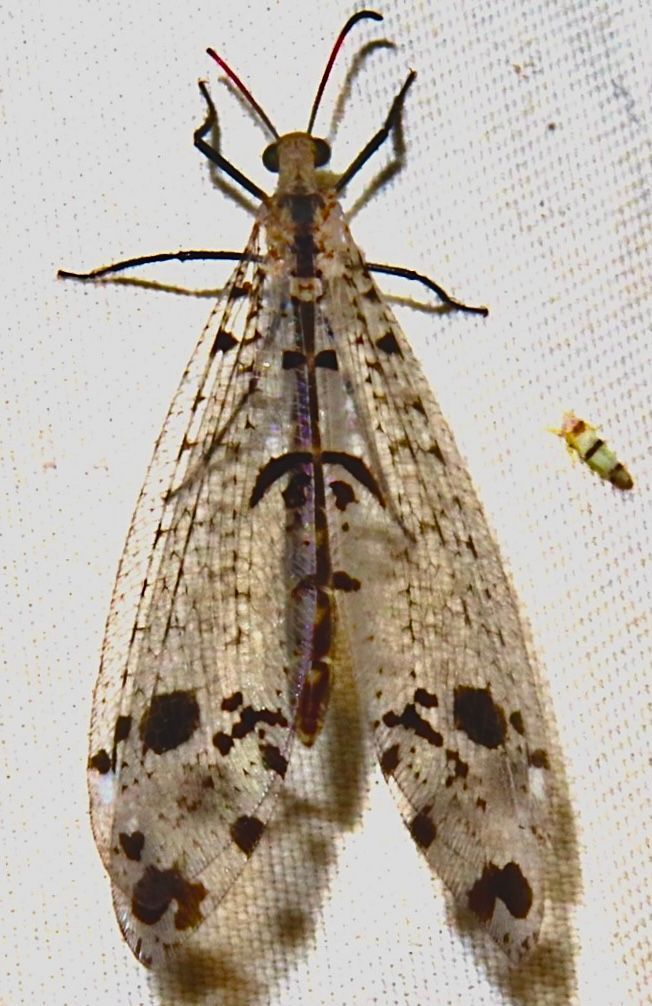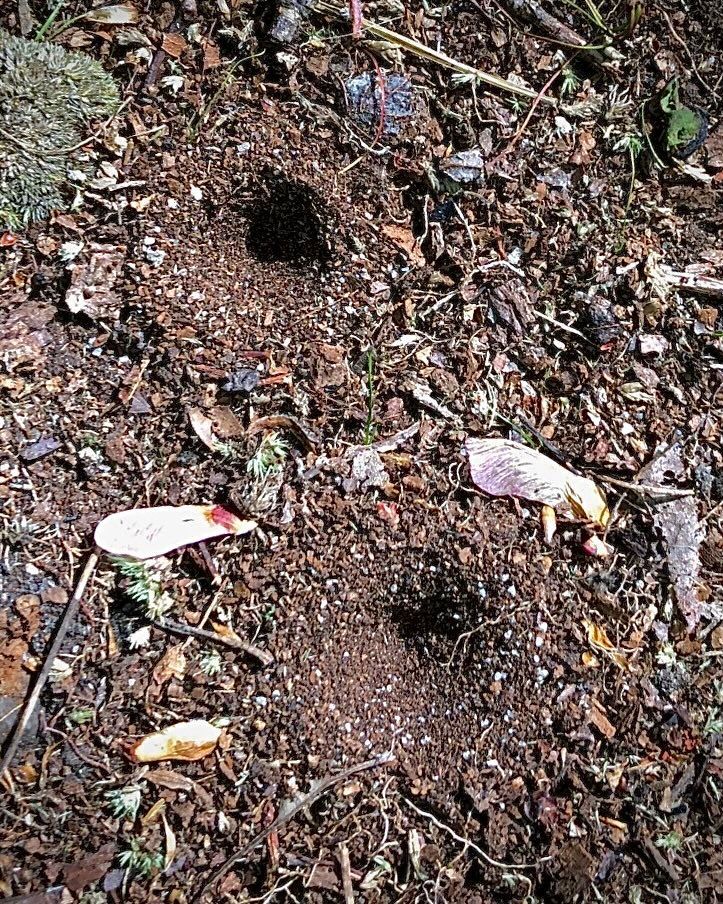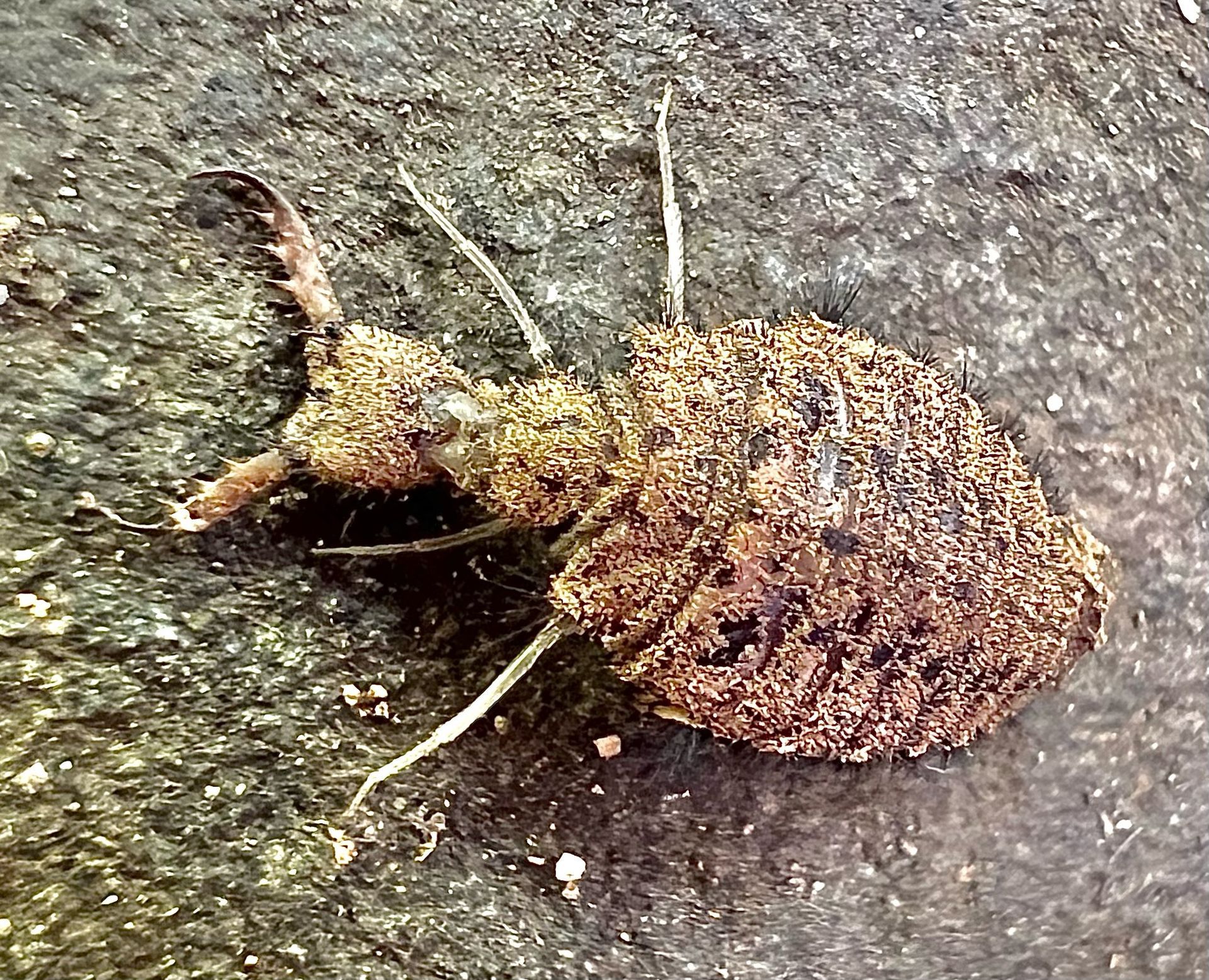"What on Earth?"
Article by Ray Barbehenn. Photos by Andy Wolfe, Ray Barbehenn, and David Cox.
Have you ever wondered what makes funnel-shaped pits in the soil, such as in the left photo? They look like tiny (two-inch-wide) bomb craters. They are typically in sandy or dusty soil, such as at the bases of rock outcrops or large trees, but they could be right next to your house. A group of these pits was found by Andy Wolfe in Michaux State Forest in southern Pennsylvania in May of 2021.
If you carefully excavate an inch below the bottom of a pit, what you find may surprise you! These pits were dug by antlion larvae. The antlion larva in the right photo (about a half inch long) was excavated from its pit by Ray in Duke Hollow (northern Virginia) on July 5. This is probably
Myrmeleon immaculatus, a widespread species in the eastern U.S. Note the large jaws sticking out in front of its head and their sharp teeth. A tiny eye is at the base of each jaw. Its broad, flat head acts like a shovel to help dig out the pit. However, its legs are weak and only used to scoot backwards! (Its third pair of legs is tucked underneath its large abdomen.)
Why do antlion larvae make pits?
A. Digging into the ground keeps them safe from predators.
B. Their pits help them trap small insects.
C. The pits are daytime resting places, since they feed at night.
D. A and C.
The answer is near the bottom of the page!
Fun Facts and Musings
The reason that antlion larvae end up in dry, dusty areas is Mom. Her preference for these sites ensures that her larvae have suitable soil in which to dig their pits. They need loose, often sandy, soil. When one of her eggs hatches, the little larva soon begins digging a little crater. It pushes backwards into the soil, plowing in a circle, and flipping soil particles outwards with its closed jaws and head. It continues inward in a spiral, getting a little deeper as it goes around and around. You can
watch a video of this behavior here. If you look carefully at the soil texture in the pits in the left photo, you can see that the larvae have removed most of the larger sand grains. Medium-sized soil particles make the best pits–pits with steep walls that collapse easily.
Antlion larvae are ambush predators: They lie in wait for prey to step into their pits and slide down their little scree slopes! Antlions can feel the subtle vibrations in the soil made by their prey as they walk on or near their pits. Some antlion species are capable of sensing vibrations from as far away as two to four inches! The contrast between the normal, uneventful life of an antlion and the moment it springs into action could not be more dramatic. As you can see in the video, an excited antlion larva does not wait for the prey to slip to the bottom of the pit. Instead, it flings little scoops of soil all over the prey as it struggles to escape. This makes the pit wall collapse under the prey and decreases its ability to get any traction. (It is one step forward and two steps backward on this scree slope.)
All the work required to make and maintain a pit usually pays off. It allows antlion larvae to catch a wide variety of prey, including species that are fast-moving (on flat ground) and relatively large. Roughly 75% of their prey includes a variety of walking insects (not just ants), and the remainder includes spiders, millipedes, and even earthworms!
The jaws of antlion larvae are highly unusual, functioning not only to grasp prey but also to inject venom. Venom flows through a unique channel in the antlion's jaws. The venom paralyzes the prey, allowing the antlion to avoid a costly struggle. In addition, the venom also contains powerful digestive enzymes. The enzymes break down the contents of the prey's body into a thick liquid. The antlion then sucks out its predigested food through the channel in its jaws. Thus, antlions actually have a liquid diet!
Antlion larvae are "sit-and-wait" predators. Not surprisingly, if they sit and wait without capturing much food, they can take one to two years to develop! They need to reach a minimum body size before they metamorphose to a pupa. Presumably, it is better to wait and grow up than to rush to become an incompetent adult.
Adult antlions are even more difficult to find than their larvae. In contrast to their larvae, adults are mainly nocturnal. The bottom photo shows an adult Eastern Spotted-wing Antlion (Dendroleon obsoletus). It was found by David Cox near SNP on August 28, 2024. He attracted it to a light at night. It was among the MANY nocturnal insects that landed on a sheet that was hung under the light. This insect was about 1.5 inches long, with a two-inch wingspan.
Notice that its wings are nearly transparent and are spotted, camouflaging it during the day when it would be asleep. These insects resemble large, drab damselflies, but they hold their wings flat to their sides instead of vertically over their bodies. In addition, notice their long curved antennae. (The left one is broken.) By contrast, the antennae of damselflies are very short and hair-like.
Adult antlions mainly feed on pollen and nectar. Thus, they are nocturnal pollinators, just like most moths. And, like most moths, they live for about a month – not nearly as long as their larvae, but similar to most adult insects.
Answer: B!
It is highly unusual for an animal to construct a pit trap. Less than 1% of all animal species build traps, and most of these species, such as spiders, build their traps with silk. When antlion larvae are out of their pits, they are more vulnerable to predators, such as lizards and birds. However, the main purpose of their pits is to catch prey, rather than to avoid predators.
Antlion larvae are kept in elementary school classrooms by some science-minded teachers. However, you don't have to fret if your teachers never gave you the opportunity to observe these insects. Just put a small insect into the next antlion pit that you come across! Can't find a bug when you need one? A small twig and a delicate wiggle can be a ready substitute for a struggling ant.
Thanks to Andy Wolfe for suggesting this topic. Send your photos and ideas for topics to Ray at rvb@umich.edu.



